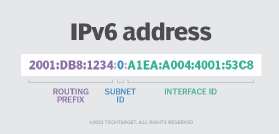Network Address Translation (NAT)
What is Network Address Translation (NAT)?
A Network Address Translation (NAT) is the process of mapping an internet protocol (IP) address to another by changing the header of IP packets while in transit via a router. This helps to improve security and decrease the number of IP addresses an organization needs.
How does Network Address Translation work?
A NAT works by selecting gateways that sit between two local networks: the internal network, and the outside network. Systems on the inside network are typically assigned IP addresses that cannot be routed to external networks (e.g., networks in the 10.0.0.0/8 block).
A few externally valid IP addresses are assigned to the gateway. The gateway makes outbound traffic from an inside system appear to be coming from one of the valid external addresses. It takes incoming traffic aimed at a valid external address and sends it to the correct internal system.
This helps ensure security. Because each outgoing or incoming request must go through a translation process that offers the opportunity to qualify or authenticate incoming streams and match them to outgoing requests, for example.
NAT conserves the number of globally valid IP addresses a company needs and -- in combination with Classless Inter-Domain Routing (CIDR) -- has done a lot to extend the useful life of IPv4 as a result. NAT is described in general terms in IETF RFC 1631.
What are the various types of NAT techniques?
The NAT mechanism ("natting") is a router feature, and is often part of a corporate firewall. NAT gateways can map IP addresses in several ways:
- from a local IP address to one global IP address statically;
- hiding an entire IP address space comprised of private IP addresses behind a single IP address;
- to a large private network using a single public IP address using translation tables;
- from a local IP address plus a particular TCP port to a global address or a pool of public IP addresses; and
- from a global IP address to any of a pool of local IP addresses on a round-robin basis.
In some cases, network administrators define policies that allow the gateway device to assign mappings based on the intended destination ("pick this external address for communications to partner A's area network; pick that external address for communications to partner B's").
Policies can also be used on the protocols being used ("assign out of this pool for HTTP traffic, that pool for HTTPS") or on other factors.
A newer way to use NAT focuses on translating an ISP provider's IPv4 addresses to IPv6, and vice versa. This provides integration of IPv4 infrastructure and end nodes into IPv6 environments, and allows IPv6 services to interact with IPv4 systems.

What is the difference between dynamic NAT (DNAT) and static NAT (SNAT)?
A dynamic NAT is common in larger organizations with complex internal networks. It uses several available IP addresses during the translation.
An example of this can be seen with Cisco, which has developed a technique that uses a NAT overload to map several private IP addresses to a single public IP address.
Conversely, a static NAT, also common in large organizations, provides a 1:1 mapping between an internal IP address and a public network IP address.

[61] copy.jpeg)





